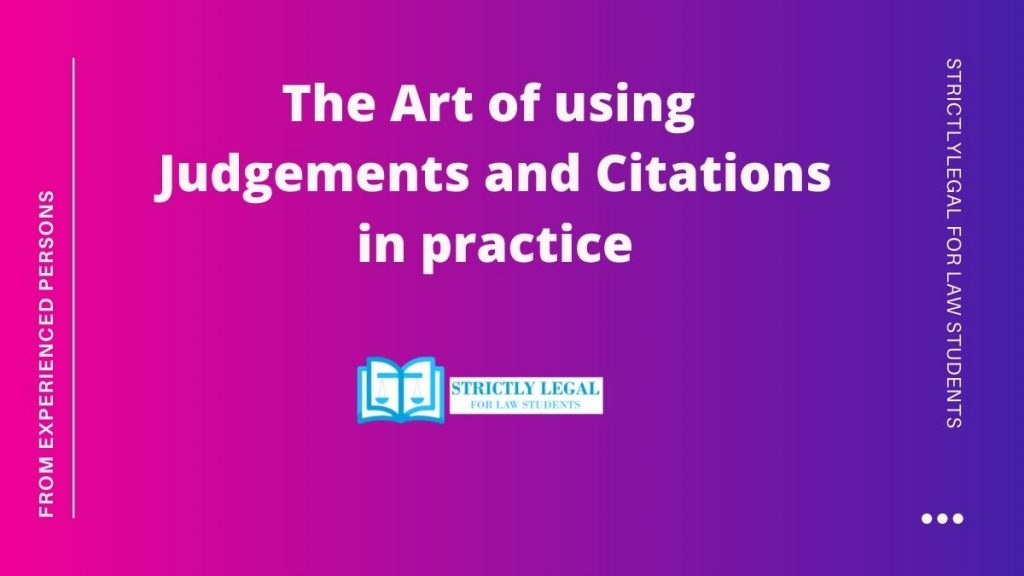Let’s start by saying that there is an over-dependence on judgments. It would be far better to incite a practice to not have that dependency as far as possible. We’ll find out the reasons soon.
It is believed by many that the beauty of the law in many ways is to research organically, to read the bare acts. A lot of times the answers that we are seeking are in the bare texts of the law. It could be a section, a proviso, a rule, or an entire article in the constitution, and many times, we are surprised to find that which we thought were not anticipated have, in fact, been considered and foreseen by the legislature at the time of enacting legislation.
Therefore, this tendency first and foremost to straight away rush to judgments to try and look at what courts have said on the point of law, creates an unhealthy dependency on case laws.
Cite when in ambiguity/necessity
Better research and a better understanding of the law should come from reading the text. It’s really in cases of ambiguity that you are required to revert to a judgment to convince the court about a point of law already considered previously.
In cases where there is no ambiguity or there is no divergence of interpretation, a judgment becomes unnecessary, and considering the Courts are working under the pressure of time, citing judgments only when we need is an important skill when it comes to litigation.
It would be wise to develop an argument first and then test it with judgments. This is when you come up with your own interpretation of the law and then find cases where the courts have taken a similar ground that you’ve prima facie come up with. This should give you a certain level of confidence and validation that you’re reading of the law in an original sense is sound that then becomes a habit. You start to look at the proposition of law originally.
Straight away Citing judgments somewhere disclosures a slight lack of confidence in our own reading or understanding of the law. Now, if we’re able to stand our ground in court and make a submission of our own understanding of the law, the court would see us as a good counselor and would acknowledge us for our original understanding of a proposition.
Yes, of course. If the court asks, is there a legal view on it? Is there a precedent on it? That is when we should go to case laws. Of course, if the case law is against us or if contrary to what we are espousing, in fairness we have to cite that position for the court.
But this habit of working bottom-up of starting with the bet of identifying the legal issues of developing that argument and then corroborating it with case law is the approach is commendable when it comes to the matter of Citing judgments in court.
Avoid case law diarrhea
As Justice Fali . S . Nariman famously quotes in his book, case law diarrhea refers to quoting 1000’s of case laws in the court when you barely need just one. That is a habit of can’t stop quoting judgments. As discussed above, citations should only be used when there’s an ambiguity in law or a question arises which has been previously decided. For example, cases like writs should not be entertained when an alternative remedy exists or whether an Injunction can be filed on a particular issue. These are general questions of law that have been answered and deemed to be known by all.
These are all well-settled principles. You would think that Judges of the high court of the Supreme court that you are arguing before are well versed. So, also in the trial court, if you’re arguing in order 39 injunction. Do you need a case law saying that there are three ingredients that the court must look at in injunction:
(1)prima facie case,
(2)irreparable harm and
(3) balance of convenience.
Would you not assume that a district judge is aware of those principles?
Now, that we know when to cite case laws/Judgements.
What sort of case laws/ Judgements should we cite?
You ought to go to a judgment where the ratio is crystal clear. Now, what is the ratio? You see this is the point your ability to find the ratio of a judgment is directly correlated to how much hard work you put in on the research of a case. Not just hard work simply in terms of downloading judgments and so on but in terms of applying your mind and analyzing case law, that has to be in your efforts.
The exercise of reading and over-reading judgments will help you arrive at the ratio of the judgment. When you cite a judgment cited for its ratio. Don’t cite it for a passing reference. Don’t cite it simply because it says something that suits you. Don’t cite it because it’s a popular cited because it has a certain ratio or an essence to it that fits in with the proposition that you are canvassing before the court.
But what is that ratio? The ratio is the pulse of the case. A ratio is determined essentially from the question that the court decides. If you’re lucky, the judgment itself will tell you what is the quest and many good judgments do that. Judgments set out the points for determination and then proceed to answer them. Once that happens to a large extent, your job is made easier because you don’t know what exactly the court is dealing with and what it has said in consequence but you may also find judgments that are not so clear.
You may find the judgment where the ratio is to be sifted out from different paragraphs. Sometimes the ratio Maybe, hidden away somewhere in the middle of the body. It may not be crystal clear at the end but then that is us as a council to read the judgment and try and understand where the central question arose.
Now, if the question is not formulated, it is for us as councilors to formulate that question. Many times it is also seen this tendency in court that will cite the judgment without taking the court to the basic facts and the question that arose.
Once you do that, that judgment is very easily distinguishable. In fact, judges get irritated with that. They ask the council to first tell them what are the facts were? what questions arose?.
That does not mean you have to give every sundry fact, then you might as well read the whole judgment that again is an honor for us to filter and you will Usually in the first two or three pairs of any judgment find the basic facts in dispute that will help you.
Was it a case of land acquisition? Was there a section for notification or not? Was it an arbitration dispute when there was a reference made or not? Was it a pre-dispute or not, etcetera, etcetera, and that process, I think becomes crucially important reducing dependency on judgments and also in playing the role of assisting the court by citing the appropriate judgment before it.
Please don’t make the mistake of filing a compilation of 30-40 judgments unless it is absolutely needed. Yes, if you are amicus curiae in a matter, it is your duty to bring every judgment on the point before the court but 99% of the cases may not require that or they may require one judgment and that is where your role in finding out whether a judgment is needed or not and which judgment is required to be cited it becomes extremely important.
Avoid Headnotes
The most dangerous and a must avoidable practice: Headnotes are not the judgment. A headnote is something that a publisher, a law reporter prepares. Some do it well and some not so well. Either way If it is not a verbatim extract of the judgment, it is not the law.
In a head note. Also, there are two species One is the telegraph head, note of what the law reporter thinks the court has decided. The other is the extract from the body of the judgment under the headboard,.Probably the latter is a slightly safer part. but again, don’t ever read that to the court. Please refer to the paragraph.
Do not cite Overrulled judgements
It is also something that directly relates to your credibility as a councilor and this is that many times you will find in court in a case that you have judgments that have been overruled being cited. Now, you may get away with it once or twice. but you won’t get away with it forever and sooner or later, the court will find out or your opponent will point it out that a judgment you have cited which may have helped you has been overruled. And that will destroy your credibility in the eyes of the court.
So, please don’t do that. You have a duty to cite the correct law.
Sometimes Cite contrary and be credible
There will be cases where you find that you have a judgment that assist you and on the other hand you will have a judgment that does not assist you in the sense that it is a view that is opposing to what you are arguing. It may be of another high court.
It may sometimes be a good practice to place that opposing view before the court. Whether you do it or not, your opponent will do it in all likelihood or the court itself may be aware of it. So, why suppress that issue? Secondly and most importantly, your credibility stands in court that here is a fair council who is bringing to the notice of the court all facts and points of law. Thirdly, Perhaps more importantly than that as well. It gives you an edge when you yourself cite a judgment that is against you. The court may be more open to listening to your submission as to how that you should be distinguished.
Conclusion
This blog post is inspired by Dr. Aditya Sondhi’s lecture on The Art of Reading and Citing Judgements. I have tried to keep the exact language that he has used and most of the times a transcript of his lecture so that the readers can engage in the way he really intends them to. The Art is really about building creditiblity and a resonsible advocacy. And I truly agree with him when he says these points will not only improve our credibility but also our role as an advocate is the assistance of the court.
Our role as a counselor is not just to argue, take an order and leave the court. That’s a simplistic view of getting along at the bar. Every advocate is an officer of the court. We are expected to assist the court in laying down the correct law. After all, what are judgments? A reflection of the assistance that the bar provided. In an adversarial system like ours. the unveiling inputs that are provided to the court by both sides or by multiple sites are really what make up the judgment. Yes, the court will have its own views and will have its own knowledge, but in an overburdened system like ours, many times the assistance that we give to the court is what leads to the judgment. So, therefore, our role in helping the court lay down the correct law also becomes extremely important.

Passionate about using the law to make a difference in people’s lives. An Advocate by profession.





